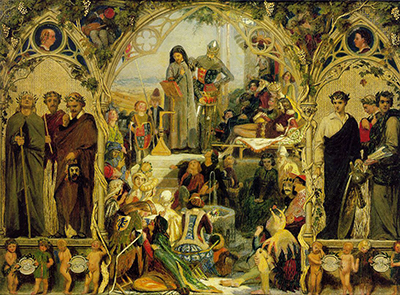Dating from 1845, The Seeds and Fruit of English Poetry is an allegorical painting in the romanticism style. The “seeds and fruits” are not literal seeds and fruits, but famous writers from throughout British history. The whole painting is a triptych, which means any painting that is split into three panels.
The central figure is 14th-century poet and writer Geoffrey Chaucer, reading to an audience of other figures from throughout English literature. The figure leaning on Chaucer’s shoulder, almost reading over his shoulder, is the armoured John of Gaunt, a staunch patron of Geoffrey Chaucer. It is thought that the reclining figure on the right (to Chaucer’s left), is the Black Prince on his death bed, notable as he died before his father, King Edward III. Other figures of note include William Shakespeare, Edmund Spenser, and John Milton on the left.
On the right, we see Lord Byron, Alexander Pope, and Robert Burns- although, of course, Burns was Scottish and not English. Each of the panels is beautifully ornate and framed with gothic arches, around which wind a multitude of vines; the literal fruit which only enforces the metaphor of the writers themselves being the seeds and their works becoming the fruit of British literature. The Seeds and Fruit of English Poetry was eventually to become a much larger piece, called “Geoffrey Chaucer Reading “Legend of Custance” to Edward III and his Court, at the Palace of Sheen, on the Anniversary of the Black Prince's Forty-fifth Birthday”, leaving us in no doubt as to the focus of the painting. Brown removed the two side wings and eliminated the gothic framework and details, moving away from the romantic style and more towards the Pre-Raphaelite style that Brown became famous for.
In the finished painting, King Edward’s son, the Black Prince, is sitting up and listening to Chaucer, rather than reclining in pain. Perhaps Brown felt that the original deathly pose was too tragic for such a celebratory painting. The original painting was composed during Brown’s travels to Rome in 1845 and completed upon his return to England. As well as the main figures, he managed to include roundels, some held by cherubic children, that showcased Keats, Shelley, Moore, Campbell, Coleridge, Wordsworth, Chatterton and Kirke White. A true celebration of some of the greatest poets up to and including the 19th Century.




